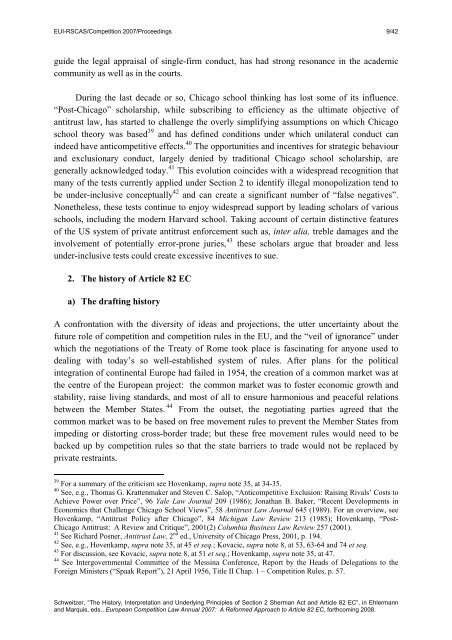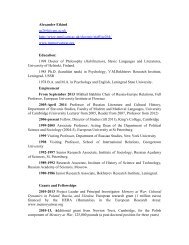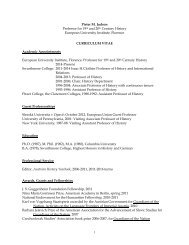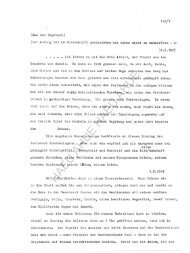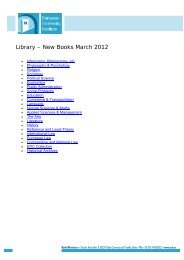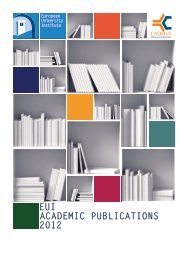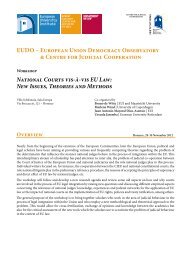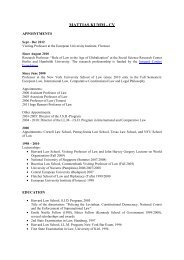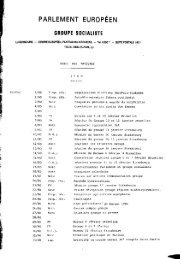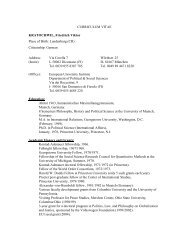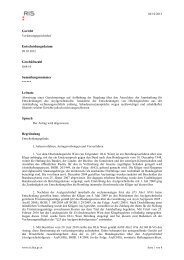The History, Interpretation and Underlying Principles of Section
The History, Interpretation and Underlying Principles of Section
The History, Interpretation and Underlying Principles of Section
You also want an ePaper? Increase the reach of your titles
YUMPU automatically turns print PDFs into web optimized ePapers that Google loves.
EUI-RSCAS/Competition 2007/Proceedings 9/42<br />
guide the legal appraisal <strong>of</strong> single-firm conduct, has had strong resonance in the academic<br />
community as well as in the courts.<br />
During the last decade or so, Chicago school thinking has lost some <strong>of</strong> its influence.<br />
“Post-Chicago” scholarship, while subscribing to efficiency as the ultimate objective <strong>of</strong><br />
antitrust law, has started to challenge the overly simplifying assumptions on which Chicago<br />
school theory was based 39 <strong>and</strong> has defined conditions under which unilateral conduct can<br />
indeed have anticompetitive effects. 40 <strong>The</strong> opportunities <strong>and</strong> incentives for strategic behaviour<br />
<strong>and</strong> exclusionary conduct, largely denied by traditional Chicago school scholarship, are<br />
generally acknowledged today. 41 This evolution coincides with a widespread recognition that<br />
many <strong>of</strong> the tests currently applied under <strong>Section</strong> 2 to identify illegal monopolization tend to<br />
be under-inclusive conceptually 42 <strong>and</strong> can create a significant number <strong>of</strong> “false negatives”.<br />
Nonetheless, these tests continue to enjoy widespread support by leading scholars <strong>of</strong> various<br />
schools, including the modern Harvard school. Taking account <strong>of</strong> certain distinctive features<br />
<strong>of</strong> the US system <strong>of</strong> private antitrust enforcement such as, inter alia, treble damages <strong>and</strong> the<br />
involvement <strong>of</strong> potentially error-prone juries, 43 these scholars argue that broader <strong>and</strong> less<br />
under-inclusive tests could create excessive incentives to sue.<br />
2. <strong>The</strong> history <strong>of</strong> Article 82 EC<br />
a) <strong>The</strong> drafting history<br />
A confrontation with the diversity <strong>of</strong> ideas <strong>and</strong> projections, the utter uncertainty about the<br />
future role <strong>of</strong> competition <strong>and</strong> competition rules in the EU, <strong>and</strong> the “veil <strong>of</strong> ignorance” under<br />
which the negotiations <strong>of</strong> the Treaty <strong>of</strong> Rome took place is fascinating for anyone used to<br />
dealing with today’s so well-established system <strong>of</strong> rules. After plans for the political<br />
integration <strong>of</strong> continental Europe had failed in 1954, the creation <strong>of</strong> a common market was at<br />
the centre <strong>of</strong> the European project: the common market was to foster economic growth <strong>and</strong><br />
stability, raise living st<strong>and</strong>ards, <strong>and</strong> most <strong>of</strong> all to ensure harmonious <strong>and</strong> peaceful relations<br />
between the Member States. 44 From the outset, the negotiating parties agreed that the<br />
common market was to be based on free movement rules to prevent the Member States from<br />
impeding or distorting cross-border trade; but these free movement rules would need to be<br />
backed up by competition rules so that the state barriers to trade would not be replaced by<br />
private restraints.<br />
39 For a summary <strong>of</strong> the criticism see Hovenkamp, supra note 35, at 34-35.<br />
40 See, e.g., Thomas G. Krattenmaker <strong>and</strong> Steven C. Salop, “Anticompetitive Exclusion: Raising Rivals’ Costs to<br />
Achieve Power over Price”, 96 Yale Law Journal 209 (1986); Jonathan B. Baker, “Recent Developments in<br />
Economics that Challenge Chicago School Views”, 58 Antitrust Law Journal 645 (1989). For an overview, see<br />
Hovenkamp, “Antitrust Policy after Chicago”, 84 Michigan Law Review 213 (1985); Hovenkamp, “Post-<br />
Chicago Antitrust: A Review <strong>and</strong> Critique”, 2001(2) Columbia Business Law Review 257 (2001).<br />
41 See Richard Posner, Antitrust Law, 2 nd ed., University <strong>of</strong> Chicago Press, 2001, p. 194.<br />
42 See, e.g., Hovenkamp, supra note 35, at 45 et seq.; Kovacic, supra note 8, at 53, 63-64 <strong>and</strong> 74 et seq.<br />
43 For discussion, see Kovacic, supra note 8, at 51 et seq.; Hovenkamp, supra note 35, at 47.<br />
44 See Intergovernmental Committee <strong>of</strong> the Messina Conference, Report by the Heads <strong>of</strong> Delegations to the<br />
Foreign Ministers (“Spaak Report”), 21 April 1956, Title II Chap. 1 – Competition Rules, p. 57.<br />
Schweitzer, “<strong>The</strong> <strong>History</strong>, <strong>Interpretation</strong> <strong>and</strong> <strong>Underlying</strong> <strong>Principles</strong> <strong>of</strong> <strong>Section</strong> 2 Sherman Act <strong>and</strong> Article 82 EC”, in Ehlermann<br />
<strong>and</strong> Marquis, eds., European Competition Law Annual 2007: A Reformed Approach to Article 82 EC, forthcoming 2008.


